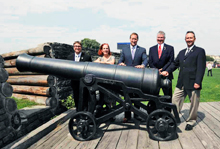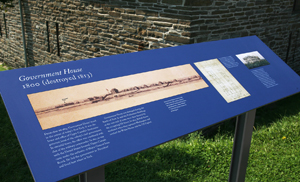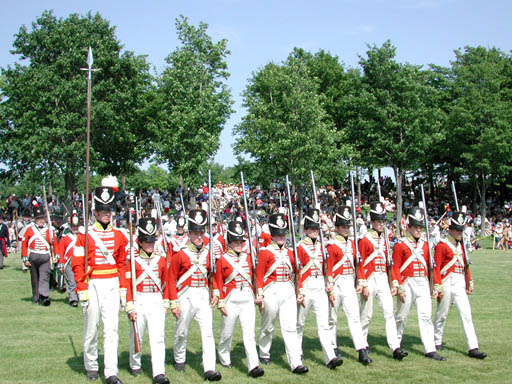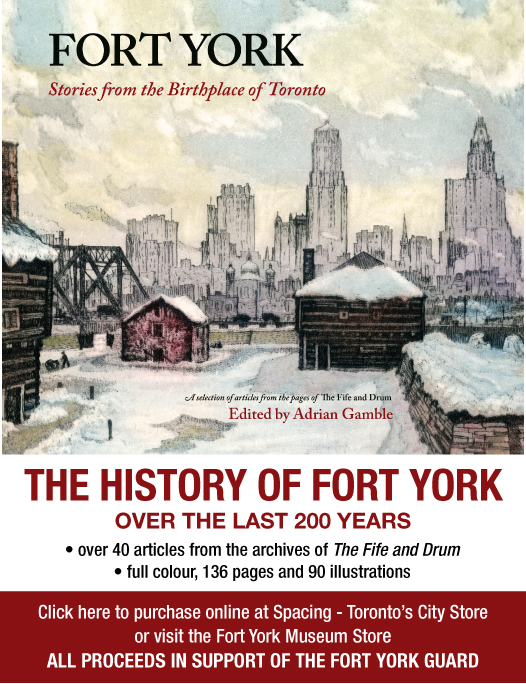Administrator’s Report (late fall 2012)
by David O'Hara, Site Administrator
2012 has certainly proved to be the busy year we all expected. In addition to our regular roster of programs and events we were able to add new offerings throughout the year. Most recently, we scheduled more than sixteen special event days in October, including the tremendously successful food symposium “Best Before 1812.” In November we hosted one of two annual Citizenship Ceremonies and at least 900 attended our Remembrance Day memorial. The year comes to a close with the Fort York Frost Fair on December 8–9 and programming throughout the weeks of December 15–31.
An expansion of activities, combined with the efforts of our staff and volunteers, has resulted in a significant increase in attendance in 2012. Staff worked hard to keep up with a calendar booked for school groups; the Canteen’s success continues; and our site rentals have increased significantly throughout the year. Largely as a result of the efforts of Kristine Williamson, Museum Outreach Officer, Fort York hosted several unique events in 2012. These included the 2012 Bliss Ball, where the Dilawri Foundation raised more than $1 million for the Sick Kids Foundation; it featured Grammy and Oscar winner Jennifer Hudson, Steven Page, and Martin Sheen. Other occasions were Diner en Blanc, many smaller private bookings, and five successful concerts on Garrison Common.
Those attending recent events at Fort York might have noticed our new team of front line volunteers–our ‘Garrison Greeters’ and ‘Heritage Hosts.’ This new program was developed then launched as a result of our ongoing partnership with the Evergreen Foundation and thanks to the financial support of RBC. Our Volunteer Coordinator, Cathy Martin, has done a wonderful job recruiting and training over 100 volunteers to assist during special events. As we move into 2013, and with the Visitor Centre opening in 2014, the roles filled by our volunteers are becoming increasingly important (visit www.fortyork.ca for more information).
In 2012 restoration work on the Stone Magazine was finally finished and an exhibit on Black Powder installed. Restoration work is also underway on both the Officers’ Brick Barracks and the Brick Magazine. Early in 2013 our new interpretive and way-finding signs will be installed. The recent start of construction on the Visitor Centre has required the closure of our Fort York Boulevard entrance. This access will be closed for the duration of construction, requiring those arriving by vehicle to use the entrance at Fleet Street and Garrison Road. When the Visitor Centre opens in 2014 Fort York will be easier to find and easier to access. It will have a more visible street presence with the main entrance at 250 Fort York Boulevard. Working with the Toronto Parking Authority, we have recently implemented a ‘Pay and Display’ parking system at Fort York. Given our location in downtown Toronto, with many other major tourist destinations in the vicinity and 6000 new units of housing to the immediate south, the need to implement such a system was pressing. The objective is to keep the small amount of parking that we have priced reasonably, but available at all hours. The majority of net revenues from the parking operation will be directed back towards programming at Fort York.
Work on the Landscape Master Plan also continues. This Plan is the clearest way of demonstrating how all of the component pieces that are Fort York come together. They are the new Visitor Centre, the Fort York Pedestrian and Bicycle Bridge, a rehabilitated and expanded Garrison Common, the Strachan Avenue Cemetery, the interface with the Fort York Armoury, and the lands that extend under Bathurst Street to CityPlace and to a new Toronto Public Library on the eastern boundary of the national historic site. Eventually, this assembly of pieces will make more sense as one coherent whole, providing a much stronger visual and physical presence for the fort and providing many more opportunities for interpretation of the site and its significance.
 Landscape Master Plan for Fort York National Historic Site. Prepared by DTAH, Toronto, 2012.
Landscape Master Plan for Fort York National Historic Site. Prepared by DTAH, Toronto, 2012.
Hon. Peter MacKay, Minister of National Defence, Visits Fort York To Award Battle Honours
On August 15, the 200th anniversary of the great victory Brock  Seen following the Toronto ceremony are (l. to r.) Ted Opitz, MP- Etobicoke Centre, Sandra Shaul of Toronto’s Bicentennial Project staff, Mr. MacKay, City Councillor Paul Ainslie, and Kevin Hebib of Fort York. Credit: MCpl Dan Pop, DNDand his Native allies won over US forces at Detroit, the Hon. Peter MacKay, Minister of National Defence, came to Fort York to announce that the Government of Canada has awarded the battle honour DETROIT to six Reserve Regiments in southern Ontario. They will now be able to emblazon this honour on their regimental colours. Receiving the award were the 56th Field Artillery Regiment of Brantford; Queen’s York Rangers (1st American Regiment) of Toronto; Royal Canadian Regiment of Petawawa; Royal Hamilton Light Infantry of Hamilton; Lincoln and Welland Regiment of St. Catharines; and Essex and Kent Scottish of Windsor. As well, the honour was accorded to the Royal Newfoundland Regiment of St. John’s at a separate ceremony there. All units are successors to those who fought under General Brock and alongside Tecumseh.
Seen following the Toronto ceremony are (l. to r.) Ted Opitz, MP- Etobicoke Centre, Sandra Shaul of Toronto’s Bicentennial Project staff, Mr. MacKay, City Councillor Paul Ainslie, and Kevin Hebib of Fort York. Credit: MCpl Dan Pop, DNDand his Native allies won over US forces at Detroit, the Hon. Peter MacKay, Minister of National Defence, came to Fort York to announce that the Government of Canada has awarded the battle honour DETROIT to six Reserve Regiments in southern Ontario. They will now be able to emblazon this honour on their regimental colours. Receiving the award were the 56th Field Artillery Regiment of Brantford; Queen’s York Rangers (1st American Regiment) of Toronto; Royal Canadian Regiment of Petawawa; Royal Hamilton Light Infantry of Hamilton; Lincoln and Welland Regiment of St. Catharines; and Essex and Kent Scottish of Windsor. As well, the honour was accorded to the Royal Newfoundland Regiment of St. John’s at a separate ceremony there. All units are successors to those who fought under General Brock and alongside Tecumseh.
On September 14 Mr. MacKay returned to Fort York to announce additional battle honours were being awarded to a wide number of regiments for QUEENSTON, MAUMEE, CHATEAUGUAY, CRYSLER’S FARM, NIAGARA, and the DEFENCE OF CANADA.
Administrator’s Report (fall 2012)
by David O’Hara, Site Administrator
After more than three decades of planning and a tremendous amount of hard work, the construction of a new Visitor Centre at Fort York National Historic Site is finally about to begin this fall.
The building, designed by Patkau Architects Inc. of Vancouver with Kearns Mancini Architects Inc. of Toronto, and costing $18 M will be constructed under a contract between the City of Toronto and Harbridge + Cross, a Canadian company with many years of experience and a wealth of industry expertise.
When complete, the Visitor Centre will house reception and visitor amenities, multimedia programming, exhibits, and facilities for education, research, and staff. Its completion will allow the fort’s administrative functions to be relocated from their present quarters within the historic structures inside the ramparts. The building, which won Canadian Architect magazine’s Award of Excellence in 2011, has been designed to reinterpret the original shoreline bluff along Lake Ontario and create a strong visual presence for the fort along the Fort York Boulevard frontage.
The whole project–construction and fixturing of the Visitor Centre, installation of exhibits, and landscaping of the surrounding Garrison Common–has been budgeted at $25 million. Of this some $19 million has been pledged by all three levels of government. The balance of $6 million will be raised from among private donors by the Fort York Foundation. For more information about the Foundation’s campaign, please visit www.fortyorkfoundation.ca.
The landscape master planning, working with landscape architects/urban designers DTAH, continues. This exercise will include the development of a detailed revitalization plan for the Garrison Common as well as a careful look at how some of the projects in areas adjacent the fort, such as the future construction of the Fort York pedestrian bridge and the reconstruction of the Bathurst Bridge, should be planned and designed to complement plans for the national historic site itself. The very basic landscaping undertaken early in the year on the Garrison Common has already allowed for extensive use of the grounds throughout the 2012 season. The next major phases of landscape improvements to the Common and the rest of the area outside the fort’s west gates will be coordinated with the Visitor Centre construction and undertaken in 2013 and 2014. Advancing this critical landscape restoration project has only been made possible by a lead gift of $1 million from the W. Garfield Weston Foundation to the Fort York Foundation.
The landscape design work at the east end of the national historic site, just to the east of Bathurst Street, was recently awarded to Public Work, a Toronto-based design studio. Public Work describes their approach to the design of the site where Garrison Creek once emptied into Lake Ontario as “A project that weaves together multiple narratives. Of geologic time, the ecology of the creek, the heritage of the fort, and the archaeological traces of the site that together uncovers the foundation of our city.”
Work also continues on various exhibit-related projects. A Parks Canada exhibit, which includes three interactive screens and one touch-table, was installed in the Centre Blockhouse earlier this summer, and the Black Powder exhibit in the Stone Magazine is now in place. After various capital improvements are completed in the Brick Magazine, the exhibit  One of the dozen new interpretive signs installed recently is found in front of the Stone Magazine. Credit: Andrew StewartFinding the Fallen: The Battle of York Remembered, which was recently on display at the Market Gallery, will be installed in the building (Fife and Drum March 2012). Our first set of twelve exterior interpretive panels was installed in early September and a second set is currently being fabricated for locations outside the fort’s walls. These signs, which were designed by Leonard Wyma of Donderdag (who also designed our new Fort York wordmark), and fabricated by WSI Sign Systems Ltd./King Architectural, will add a new layer of interpretation to the entire site.
One of the dozen new interpretive signs installed recently is found in front of the Stone Magazine. Credit: Andrew StewartFinding the Fallen: The Battle of York Remembered, which was recently on display at the Market Gallery, will be installed in the building (Fife and Drum March 2012). Our first set of twelve exterior interpretive panels was installed in early September and a second set is currently being fabricated for locations outside the fort’s walls. These signs, which were designed by Leonard Wyma of Donderdag (who also designed our new Fort York wordmark), and fabricated by WSI Sign Systems Ltd./King Architectural, will add a new layer of interpretation to the entire site.
Fort York National Historic Site benefits from $1 million gift by the W. Garfield Weston Foundation
 On 14 June, the City of Toronto and the Fort York Foundation announced that the W. Garfield Weston Foundation is making a $1 million gift to the Fort York Foundation to initiate the rehabilitation of Garrison Common. The Common, the open ground and park west of Fort York and part of the 43 acres comprising Fort York National Historic Site, contains an archaeological site, a military cemetery and forms part of the ground where the Battle of York was fought on 27 April, 1813. The Fort York Foundation is currently engaged in a $7-million capital campaign to obtain funds from the private sector to support the City’s ongoing invigoration of Fort York National Historic Site, which currently has commitments from City, Provincial and Federal governments totalling $19 million.
On 14 June, the City of Toronto and the Fort York Foundation announced that the W. Garfield Weston Foundation is making a $1 million gift to the Fort York Foundation to initiate the rehabilitation of Garrison Common. The Common, the open ground and park west of Fort York and part of the 43 acres comprising Fort York National Historic Site, contains an archaeological site, a military cemetery and forms part of the ground where the Battle of York was fought on 27 April, 1813. The Fort York Foundation is currently engaged in a $7-million capital campaign to obtain funds from the private sector to support the City’s ongoing invigoration of Fort York National Historic Site, which currently has commitments from City, Provincial and Federal governments totalling $19 million.
In his remarks at Fort York on 14 June, Geordie Dalglish, a director of the W. Garfield Weston Foundation, said: “We are very pleased to support this important heritage, environmental and city-building project. Fort York National Historic Site has played a central part in the history and evolution of our city and our province, and the W. Garfield Weston Foundation is proud to play a lead role in elevating the profile of this important asset in the Toronto cultural landscape to a widely diverse population of visitors, Canadian-born and newcomers alike”.
An interpretive panel showing the preliminary landscape plan will be displayed in Garrison Common, and at Fort York, while this rehabilitation work is underway, expected to occur in stages over the next few years.




